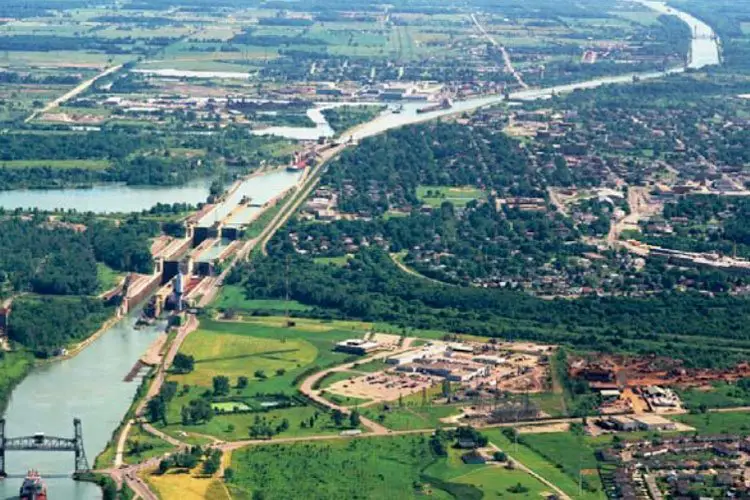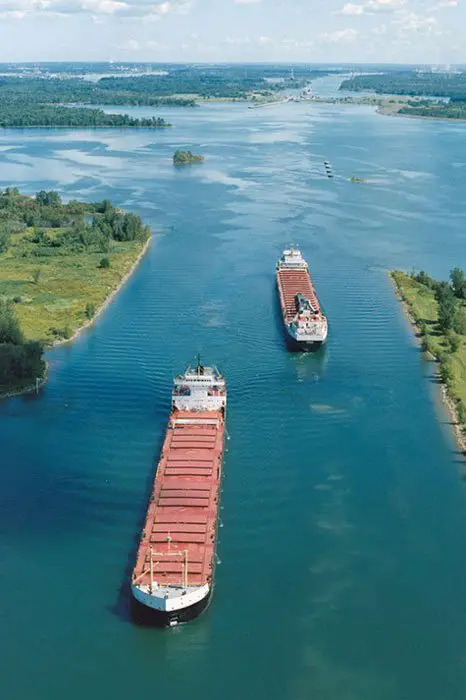
[ad_1]
St. Lawrence Seaway is a full-fledged waterway system that includes locks, channels, and canals that connects the Great Lakes to the Atlantic Ocean. Its length is 2,342-miles or 3,768-kilometer and is a major trade shipping route for both Canada and the USA.
It came into use in 1959. There is a long history related to the plans for the construction of the seaway and the advantages and disadvantages that had to be faced by the people because of this seaway’s construction.
Let us take a look at its history, construction process, geography, and its important facts.
History of St. Lawrence Seaway
St. Lawrence seaway construction has a long political history. Many disputes among the official boards and the Presidents of the US and Canada happened for this project. The proposal for the project was first made in the 1890s. The project was to make a binational deep waterway along the St. Lawrence River. It was a Hydropower project which will be beneficial for both the country’s ship travels.
Both the US and Canada showed interest in the project and it was then given to a group for the study. The project was approved but afterward, the Prime Minister of Canada was a bit hesitant to proceed because of the opposition from the Quebec government. Later, the Ontario government also opposed the project.
Treaty for the project was made between the two nations but it failed many times. However, by 1941 the US president and Canadian Prime Minister came to a common conclusion of building the seaway but then it was opposed by the US Congress.
It was difficult to convince the US Congress to show support to the project. Hence, Canada decided to work on the project alone in 1951. Then in 1954, the US president approved the joint construction of the project.
After all these political debates the construction of the seaway started on 10 August 1954.
Also read: Interesting facts about Suez canal

St. Lawrence Seaway: A Vital Waterway For Canada & USA
Construction
As we saw earlier, the construction of the seaway was a difficult journey. After all the official debates, it was finally decided to be constructed.
The construction of the St. Lawrence Seaway started on August 10, 1954, and the project was completed in 1959. It took four years to build this extremely important seaway.
Around 22,000 people worked on this project at a time. It was a mammoth task involving moving 210 million cubic yards of rock and mud. Over 6 million cubic yards of concrete were used.
A hefty task of constructing a 2,300-mile-long seaway which is not less than a superhighway for ocean freighters was done by these thousands of workers. It almost cost 470 million Canadian Dollars, out of which 336.2 million dollars were paid by the government of Canada.
Although it was a boon or bane condition for the project as many people were not happy with the idea. On one hand, this project was going to be very successful in terms of import-export facilities of large amounts of goods and turn out to be beneficial in economical aspects for both US and Canada.
On the other hand, it was not acceptable for the people living near the St. Lawrence River. All the settlements had to be removed from the area of the project. Due to this reason even if the project served to be economically healthy it did not mean the same to the people who had to adjust to changes that came with it.

St. Lawrence Seaway Aerial View
Geography
The seaway stretches from the Atlantic Ocean to the Great Lakes of North America and extends till Duluth, Minnesota which is to the western end of Lake Superior. The seaway is named after the St. Lawrence river and this river flows from Lake Ontario to the Atlantic ocean. In legal terms, the extension of the seaway is from Montreal, Quebec to Lake Erie which is a part of the Great Lakes including the Welland Canal.
However, it is not a continuous canal as several locks, dams and navigable channels are present in between its way. The length of the seaway is 1.197 km. The maximum height above sea level here is 170 m. Around 15 locks are constructed throughout the seaway among which 7 are present at the St. Lawrence River portion. The plan for expansion of the seaway was made by the US Army Corps of Engineers but it was not approved because of tight budgets.
Facts about St. Lawrence Seaway
The seaway has proved beneficial in many different aspects. It was built with a lot of complications but has come up as a significant route. There are some more facts about the seaway that we need to know.
Revenue
The revenue of $3.4 billion is generated annually in the US by the Great Lakes and the seaway combined. Around 222 million tons of cargo ships traveled through the seaway in 2002. The foreign shipments of inbound steel and outbound grains make up 15.4 million tons which are 6.9 % of the total cargo that is moved. It is estimated that more than 2.5 billion tonnes of cargo valued at $375 billion have moved since 1959.
Economy
The seaway became a boon for Canada’s economy. Canada used to be an importer of iron ore but after the discovery of large iron ore reserves in Quebec and Labrador and the construction of the St. Lawrence Seaway, it became an exporter to the United States. Canada also started exporting grains to the United States. The third major commodity transported through this seaway is coal from the United States to Candian Steel Mills and power plants.
Locks
The locks in the seaway enable a ship to climb up to 168 meters. A lock fills to a quantity of 91 million liters of water in 7-10 minutes.
Power Generation
It is the main source of generation of hydroelectric power. Beauharnois Power Plant is located here in the St. Lawrence River.
Freshwater reserves
More than one-fourth of the freshwater reserves of the Earth are drained by the St. Lawrence Water System.
Depth
The maximum depth of the St. Lawrence River is 250 feet which is the deepest of the river.
Seaway Traffic
The seaway traffic traveling to and from foreign ports make up 25 %. These ports are usually from Europe, Africa, and the middle east.
Ports
Some of the largest ports of North America are located at this seaway.
Tourism
Tourism activities like scuba diving, fishing, boating, cruising, canoeing, and camping can be enjoyed in the St. Lawrence River area.
The seaway is an important part of the shipping industry of both countries. It has emerged to be a very significant route for ship travel. We saw the history related to the seaway and the way it was constructed, its geography, and some of the quick facts. I hope this article was informative and helpful.
Images courtesy:
- Wikimedia
- Wikimedia
[ad_2]
This article has been posted as is from Source